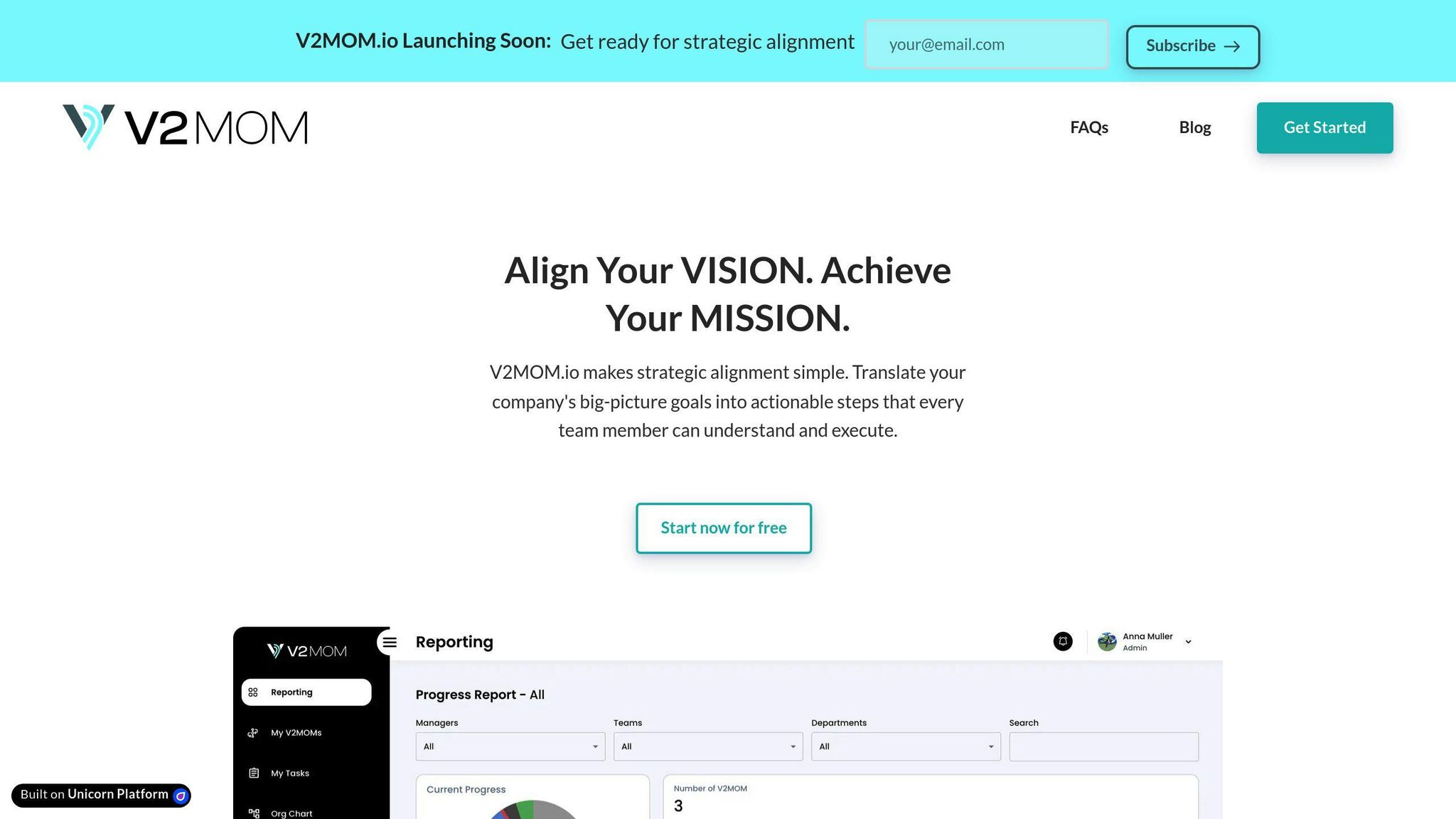Strategic planning doesn’t have to be overwhelming. Follow these 8 steps to create a clear and actionable roadmap for your goals:
- Define Vision and Mission: Set your organization's direction with clear, inspiring statements.
- Conduct Environmental Analysis: Use tools like SWOT and PESTLE to assess internal and external factors.
- Set Strategic Objectives: Create SMART goals that are specific, measurable, and time-bound.
- Develop Action Plans: Assign tasks, allocate resources, and set deadlines.
- Implement the V2MOM Framework: Align teams with a structured approach to vision, values, methods, obstacles, and measures.
- Establish Key Performance Indicators (KPIs): Track progress with measurable metrics.
- Execute and Monitor Progress: Regularly review performance and adjust plans as needed.
- Review and Update the Strategy: Keep your plan relevant with quarterly reviews and updates.
Quick Tip: Use tools like V2MOM.io or dashboards to streamline tracking and execution. This process ensures your strategy stays focused, measurable, and adaptable over time.
The Complete Strategic Planning Checklist
1. Define Vision and Mission
A clear vision and mission are the backbone of any strategic plan. They guide decisions, align focus, and set the stage for analyzing your environment and establishing goals.
Create a Clear Vision Statement
Your vision statement captures the future you aim to achieve. It should be inspiring, practical, and serve as a north star for long-term decisions. Amazon’s vision statement is a great example: "To be the world's most customer-centric company".
Here’s how to craft a strong vision statement:
- Keep it short - one memorable sentence.
- Look ahead 5-10 years.
- Make it motivational for your team.
Develop a Focused Mission Statement
If the vision outlines where you’re headed, the mission explains why you exist and what you do. Take Google’s mission statement: "To organize the world's information and make it universally accessible and useful".
An effective mission statement should include:
- Purpose: Why your organization exists (e.g., solving customer challenges).
- Values: Principles that guide your actions, like integrity or creativity.
- Impact: The outcomes you aim to deliver for stakeholders.
Align Vision and Mission with Goals
Your vision and mission should directly influence your strategic goals. This alignment ensures that every objective supports your organization’s purpose. To achieve this:
- Use the frameworks discussed in later steps of the process.
- Develop measurable goals that reflect the aspirations in your vision. These will be covered in more detail in subsequent steps.
2. Conduct Environmental Analysis
Analyzing external and internal factors is crucial for shaping your strategy. This process helps pinpoint what could influence your success. Here's how you can break it down:
Perform a SWOT Analysis
SWOT helps you evaluate four key areas:
- Strengths: What gives your business an edge? Think about your resources, skills, or anything that sets you apart.
- Weaknesses: Where do you fall short? Identify areas that might hold you back.
- Opportunities: Look at market trends, emerging technologies, or any chance to grow or improve.
- Threats: Consider competitors, changes in regulations, or challenges in your industry.
Scan External Forces with PESTLE
PESTLE focuses on external factors that could influence your strategy:
- Political: Government policies, trade rules, or political stability.
- Economic: Inflation, market conditions, or consumer spending habits.
- Social: Shifts in demographics or changes in customer preferences.
- Technological: New tools, automation, or advancements in your field.
- Legal: Laws and regulations you need to follow.
- Environmental: Factors like climate impact or resource availability.
Identify Key Stakeholders
To understand who influences your decisions:
- List all relevant individuals or groups.
- Evaluate their level of influence or decision-making power.
- Clarify what matters most to them in the decision-making process.
This mapping helps guide your Methods and Metrics in the V2MOM framework. These steps are essential for setting clear priorities in the next phase.
3. Set Strategic Objectives
After analyzing insights using tools like SWOT and PESTLE, it's time to turn that information into actionable goals. This step is about making your analysis work for you by creating clear, focused targets.
Establish SMART Goals
SMART goals help you turn your strategy into measurable, achievable outcomes. For instance, a goal like "Increase Northeast market share by 25% through metro-focused campaigns by Q4 2025" meets all SMART criteria: it defines a specific region, sets a measurable percentage, is realistic (metro focus), aligns with broader goals (market growth), and has a clear deadline.
| SMART Component | Description | Example |
|---|---|---|
| Specific | Clearly define the goal | Increase market share in the Northeast region |
| Measurable | Use metrics to track progress | Grow by 25% within 12 months |
| Achievable | Ensure it's realistic given resources | Target top 3 metropolitan areas |
| Relevant | Align with broader goals | Contribute to revenue growth strategy |
| Time-bound | Set a deadline | Achieve by Q4 2025 |
Prioritize Objectives
Not all objectives carry the same weight, so prioritization is key. Consider:
- Impact on your overall strategy
- Resource demands
- How goals depend on each other
When setting priorities, aim to balance short-term needs with long-term benefits. This approach ensures your objectives guide resource allocation effectively in the next planning phase.
4. Develop Action Plans
This step turns your prioritized objectives from Step 3 into concrete tasks that can be executed effectively.
Assign Responsibilities and Deadlines
Clear accountability is key to successful execution. Start by outlining the main deliverables and assigning the right team members to lead each task. A responsibility matrix can help clarify roles:
| Role Type | Core Function |
|---|---|
| Project Lead | Manages overall execution and coordinates team efforts |
| Task Owner | Takes charge of specific tasks or deliverables |
| Stakeholder | Offers input and approves progress at critical points |
Set deadlines by working backward from your goals. Break larger objectives into smaller, manageable milestones, each with its own deadlines and checkpoints.
Allocate Resources
Evaluate your resources across three key areas:
| Resource Type | Planning Considerations | Allocation Tips |
|---|---|---|
| Financial | Budget limitations and ROI goals | Focus on initiatives with high ROI |
| Human | Team skills and availability | Distribute tasks evenly |
| Technical | Tools and infrastructure requirements | Maximize use of current systems |
For better resource management, consider these tips:
- Regularly review team capacity and adjust workloads every two weeks.
- Set aside a 15-20% contingency buffer to handle unexpected challenges.
With these steps in place, your team will be well-prepared to implement the V2MOM framework effectively in the next phase.
sbb-itb-ee93501
5. Implement the V2MOM Framework
Once you've outlined your action plans, the next step is to use the V2MOM framework. This approach helps keep teams aligned and focused on the primary goals throughout the execution process.
Breaking Down the V2MOM Framework
The V2MOM framework includes five key elements, each playing a specific role:
| Component | Purpose | Key Points to Keep in Mind |
|---|---|---|
| Vision | Describes the desired outcome | Should be clear, inspiring, and have a set timeline |
| Values | Shapes decisions and behaviors | Represents the core principles of the team or organization |
| Methods | Specifies the actions to take | Tactical steps needed to achieve the vision |
| Obstacles | Highlights potential roadblocks | Anticipates challenges that may arise |
| Measures | Tracks performance and results | Uses measurable metrics tied to your goals |
Using V2MOM.io for Execution

Digital tools like V2MOM.io simplify the process of putting this framework into action. These platforms offer features like shared dashboards for tracking goals and aligning resources, helping teams stay on course and monitor progress effectively.
6. Establish Key Performance Indicators (KPIs)
With your action plans and the V2MOM framework in place, it’s time to set measurable targets to keep everything on track. Key Performance Indicators (KPIs) help translate your strategic goals into clear, measurable outcomes. The key is to focus on metrics that tie directly to your SMART goals while considering both your internal strengths and weaknesses (SWOT) and external market factors (PESTLE).
Choose the Right Metrics
Your KPIs should directly support the strategic goals outlined in your V2MOM framework, particularly the "Measures" column. Avoid vanity metrics that look impressive but don’t provide real value. Instead, focus on data that leads to actionable insights.
| KPI Category | Example Metrics |
|---|---|
| Financial | Revenue Growth, Profit Margins, ROI |
| Customer | Net Promoter Score (NPS), Retention Rate, Customer Satisfaction |
| Operational | Project Completion Rate, Resource Utilization, Time-to-Market |
| Strategic | Market Share |
Tips for selecting KPIs:
- Align with goals: Every KPI should directly reflect a strategic objective.
- Stay focused: Too many KPIs can dilute focus - stick to the essentials.
- Trackable and measurable: Choose metrics that can be consistently and accurately monitored.
- Set clear deadlines: Define when and how often KPIs will be measured.
Build Dashboards for Monitoring
Tracking KPIs effectively requires a good visualization system. Modern dashboard tools make it easier for teams to stay aligned, monitor progress, and make informed decisions based on real-time data.
When designing your KPI dashboard:
- Organize for clarity: Use a clear visual structure that links goals to their corresponding metrics.
- Ensure accessibility: Make dashboards available to all relevant stakeholders.
- Review regularly: Schedule monthly or quarterly reviews to evaluate performance and adjust as needed.
A well-maintained dashboard keeps everyone on the same page and ensures your KPIs drive meaningful progress.
7. Execute and Monitor Progress
Once your KPIs are in place, it's time to focus on consistent execution and tracking. Use a structured review process to keep things moving and refine your approach with data.
Review Progress Against KPIs
Regular reviews are essential to stay on track. Here’s a breakdown of how to approach them:
| Review Type | Frequency | Focus Areas |
|---|---|---|
| Team Check-ins | Weekly | Immediate obstacles, quick wins |
| Department Reviews | Monthly | KPI trends, resource allocation |
| Executive Reviews | Quarterly | Strategic alignment, major adjustments |
Keep a close eye on four key areas: performance gaps, resource use, milestone progress, and emerging risks.
Make Data-Driven Adjustments
Success relies on making informed decisions based on actual performance data. Avoid relying on instincts or assumptions - let the numbers guide you.
"The plan will not be effective without processes and metrics that ensures everyone is doing their part." - Training Course Material, "8 Step Strategic Planning Process"
Building an Adjustment Framework:
When making adjustments, focus on:
- Patterns over time, not isolated anomalies
- Changes in the market or competitor activity
- Feedback from frontline teams
- The impact on resources and capacity
Tie any changes back to your V2MOM Methods. This ensures you stay focused on core goals while addressing immediate issues. Be cautious about making knee-jerk changes that could disrupt long-term priorities.
These adjustments set the stage for the quarterly strategy reviews outlined in Step 8.
8. Review and Update the Strategy
Strategic plans need regular updates to remain effective and aligned with goals. This step is all about keeping the strategy on track while adjusting to changes.
Conduct Regular Strategy Reviews
Set up a structured review system to evaluate how well the strategy is working:
| Review Level | Frequency | Key Focus Areas |
|---|---|---|
| Leadership Review | Quarterly | Strategic alignment, market trends |
| Department Level | Monthly | Progress on initiatives, resource use |
| Project Teams | Bi-weekly | Tactical execution, immediate challenges |
When reviewing, focus on these key areas:
- Performance vs. Targets: Compare actual outcomes with your goals.
- Market and Industry Changes: Look at competitor actions, market shifts, and trends.
- Resource Use: Assess whether budgets and team capacities are being used effectively.
- Stakeholder Input: Collect feedback from employees, customers, and partners.
Encourage Ongoing Improvement
"You need data and metrics to determine what success looks like. It is also a key element of continuous improvement".
Focus on making small, targeted changes instead of sweeping overhauls. To keep things moving:
- Clearly document every adjustment and explain why it’s being made.
- Share updates openly with the entire organization.
- Offer training and resources to support new initiatives.
- Track the results of changes to measure their impact.
"Your strategic plan should be a living, breathing thing, as you constantly reassess and pivot as needed." - LBL Strategies
The V2MOM framework can help validate updates, especially when examining the Measures and Obstacles components. Make sure to prepare detailed agendas, involve key stakeholders, and keep records of all decisions made.
Conclusion and Next Steps
Summary of the 8 Steps
This checklist outlines a clear path for strategic planning, ensuring each step contributes to achieving long-term goals.
| Step | Key Focus | Strategic Role |
|---|---|---|
| Vision & Mission | Setting the foundation | Establishes direction and purpose |
| Environmental Analysis | Understanding the market | Identifies opportunities and risks |
| Strategic Objectives | Defining goals | Sets measurable targets |
| Action Plans | Allocating resources | Ensures actionable steps |
| V2MOM Implementation | Adopting a framework | Keeps the organization aligned |
| KPI Establishment | Setting metrics | Tracks progress effectively |
| Execution & Monitoring | Implementing plans | Ensures accountability |
| Review & Updates | Keeping plans relevant | Maintains ongoing relevance |
Balancing Consistency and Flexibility
Since 1970, the average lifespan of companies has significantly decreased, emphasizing the need for strategic planning that is both steady in execution and adaptable to change.
Tips for Effective Execution
- Schedule annual strategic reviews, ideally in late summer or early fall.
- Use visual tools to keep your plan front and center.
- Appoint a dedicated "strategy engineer" to oversee the process.
- Involve diverse teams to avoid groupthink and improve decision-making.
- Maintain open communication across all levels of the organization.
- Base adjustments on data-driven insights for better outcomes.
Strategic planning isn't a one-and-done task - it's a continuous effort. As Boston Consulting Group puts it:
"It is more important than ever to be prepared strategically."
Think of your strategic plan as a living document. It should grow and adapt with your organization while staying true to your core vision and values. Regular reviews and timely updates will ensure your strategy remains effective and actionable. By embracing this approach, your organization can stay on track and ready for the challenges ahead.
FAQs
What are the 8 steps of strategic planning?
The 8 steps of strategic planning lay out a clear path to success:
- Define vision and mission: Set the overall direction.
- Analyze the environment: Use tools like SWOT and PESTLE to evaluate internal and external factors.
- Set SMART objectives: Create specific, measurable, achievable, relevant, and time-bound goals.
- Develop action plans: Assign resources and establish timelines.
- Use the V2MOM framework: Align teams and priorities.
- Establish KPIs: Identify metrics to measure progress.
- Execute and monitor progress: Use data to review performance.
- Review and update regularly: Adapt to changes and refine the strategy.
Each step builds on the previous one, ensuring a structured and effective approach to planning.
What are the 5 steps in strategic planning?
For a simpler process, these five steps focus on the essentials:
- Assess the current environment: Understand where you stand.
- Set clear goals and objectives: Define what you want to achieve.
- Create a focused plan: Include measurable outcomes.
- Implement and align: Ensure everyone is on the same page.
- Review and adjust: Continuously refine the plan based on results.
This approach is ideal for smaller teams or when speed is a priority.
What are the elements of a V2MOM?
The V2MOM framework, introduced by Salesforce CEO Marc Benioff, is a tool for aligning an organization around a shared vision.
"The V2MOM framework was born out of my experience at Salesforce, where I needed a simple yet powerful tool to align the entire company around a shared vision and strategy"
It includes five components:
- Vision: What you aim to achieve.
- Values: The guiding principles for decision-making.
- Methods: Steps to reach the vision.
- Obstacles: Challenges to overcome.
- Measures: Metrics to track progress.
Platforms like V2MOM.io make it easier to implement and monitor this framework in real time.

